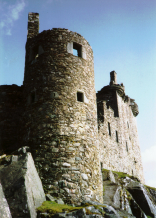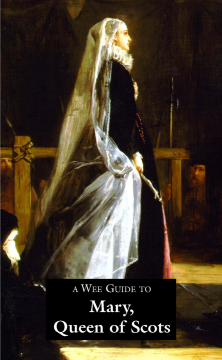Mary Queen of Scots: The Infant Queen
On the 8 December 1542 a baby girl was born at Linlithgow Palace. Although her father knew of her birth he would never see her, as he died when she was just six days old. The infant Mary became queen of Scots at this tender age, and
as a result of her father’s precipitous death, the consequences of religious strife and political struggles in Scotland as well as in the rest of Europe, the life of this child-queen was never going
to be straightforward.
Following the death of James, the war with Henry VIII and England was ended after negotiations conducted by James Hamilton, Earl of Arran, who, as the heir presumptive, had been
appointed Lord Governor to rule Scotland during Mary’s minority. The treaties that Arran agreed to at Greenwich in July 1543 included terms for peace and for the marriage of Mary to Henry VIII’s son
Edward, but they were not popular with many of
the Scots nobles.
The infant Queen was taken to Stirling Castle by her mother for safety, where she was crowned in the Chapel Royal on 9 September. As Mary was an infant, she had nothing to do with the running of the country, and The Governor (Arran), her mother and Cardinal Beaton administered the country on her behalf.
Apart from uneasy relations with England, the Scottish regency had both internal political and religious problems, and relations with France to deal
with. Political loyalties were influenced to some extent by religious beliefs or persuasion, and the triumvirate was not always united. Mary of Guise and Catholic Cardinal Beaton were essentially
pro-French, but Arran, along with some of the other Scottish nobles including Cassillis, Angus, Glencairn and Rothes, were more pro-English in both political and religious matters.
By December 1543 the Scottish parliament had repudiated the Treaties of Greenwich, much to Henry’s annoyance. When Arran had agreed to them, the political allegiances of the Scots
were complicated by their religious affiliation, and the eventual rejection of the treaties led to a revival of Catholic power in Scotland, led by Cardinal Beaton and Mary of Guise. Their supporters
included Huntly, Lennox, Argyll and Bothwell. Although Beaton’s policy was ostensibly religious in nature, his attempts to stamp out the spread of heresy and anti-Catholic feeling in the country,
resulted in severe political and economic consequences.
In retaliation for the behaviour of the Scots Henry embarked on a series of raids into Scotland during 1544 and 1545, mainly in the border area, but also
as far north as Edinburgh. These raids, known as the Rough Wooing, were led by the Earl of Hertford, and resulted in the looting and burning of the abbeys at Holyrood Palace, Melrose, Jedburgh, Kelso and Dryburgh. Crops and ships were also stolen.
Not all of the Scottish nobles suffered badly from these events, as some duplicitous families, (the Assured Scots) such as the Grays, swore allegiance to Henry as a result of
bribery or bullying, and were granted pensions.
During the early years of the Rough Wooing, the Scots were not very successful in dealing with the English, but the tables were turned at Ancrum Moor
(near Jedburgh) early in 1545. As a result of the destruction of the Douglas Tomb at Melrose by a troop of English, Scots and mercenaries, the Earl of Angus (a Douglas himself and until then a
supporter of the English) along with Scott of Buccleuch and Lesley of Rothes led about 1500 men against 3000 English troops under Sir Ralph Eure. Although the resulting defeat and slaughter of the
English temporarily raised the morale of the Scots, it did not end the war.
At the time of the Rough Wooing other events were taking place in Scotland which would have long-term effects on the country. Throughout the sixteenth century, the
Reformation affected the whole of Europe, and Scotland was no exception. In the eastern ports of Aberdeen, Dundee, Leith and St Andrews Lutheran ideas and literature were imported. Much has been
written about whether the Scottish Reformation was a result of dissatisfaction with the Catholic church, which was accused of corruption and greed, or an increasing desire for the individual
spirituality and responsibility advocated by protestantism. Whatever the reasons, during the 1540s and 1550s there was as much religious as political unrest in Scotland. Cardinal Beaton, as
Archbishop of St Andrews, was head of the church in Scotland. He also had great political power as he was appointed Chancellor in January 1543 and as such influenced the policies of the first
administration during Mary’s minority. The practice of celibacy by clerics was not officially sanctioned by the church until the final debates of the Council of Trent in 1564 and so, like many other
churchmen of the time, Cardinal Beaton had a mistress by whom he had three children. Beaton built Melgund Castle (near Brechin) for them.
Although he may not have burnt as many heretics as in other countries, Beaton still sent several to the stake, most importantly George Wishart. The burning of Wishart at St Andrews
in 1546 may have been a turning point for the Reformation in Scotland, and it was certainly to prove very serious for Beaton himself. As a result of this execution, Norman Leslie, James Melville,
Kirkcaldy of Grange and some others stole into St Andrews Castle where
Beaton was, and murdered him. His naked dead body was hung from one of the windows to demonstrate what had been done in retaliation for Wishart’s death.
The removal of Beaton from the political and religious scene did not lead to an overall volte face, or reversal, in Scottish politics and religion. Mary of Guise’s own personal
authority increased and, as a result of her influence, Arran ordered the castle to be besieged. The siege of St Andrews Castle might have resulted in a humiliating defeat for Mary and Arran as the
castle was well provided with food and ammunition to withstand an attack of several months. Among the besieged was John Knox, who would court controversy on several occasions in the future.
The stalemate was not broken, even by the English reinforcing the castle, until the French appeared in support of Mary. The French king François I had died and his successor Henri
II had placed the Duke of Guise and the Cardinal of Lorraine, Mary of Guise’s brothers, in positions of power. They sent a fleet of 20 ships whose ordnance was to prove successful against the English
troops and the Castilians. The mine and counter-mine which were tunnelled under St Andrews Castle during the siege can still be seen.
During the first few years of her life, Mary was brought up with her half-brothers and sisters, Lord James, Lord Robert and Lady Jean Stewart speaking Scots, well away from the
day-to-day problems of the country. As well as assuring her future as queen, her mother had Mary’s immediate future survival to consider, as the threat from England persisted.
With the death of Henry in January 1547, the English crown also passed to a minor, Edward VI, but the country was governed by the Earl of Hertford, now the Duke of Somerset, who
built forts in the south-east of Scotland from Berwick to Dundee, concentrating his English troops at Haddington. He engaged the Scots in battle at Pinkie, near Musselburgh, on 9 September
1547.
The Scots were led by the Earl of Arran and there were reportedly 30 000 men drawn from throughout Scotland. Unfortunately, although the Scots
outnumbered the English, the English were more professionally organized, trained and equipped, and by the end of the fighting 10 000 Scots were dead and a further 1500 taken
prisoner. Pinkie was a victory for the English, but hostilities between the two countries were to continue for another three years, and increased Scottish dependency on France.
Mary’s safety was paramount and the threat of possible capture by English troops led to her being moved around the country: in 1547 she was sent to Inchmahome Priory (on the Lake
of Mentieth, near Stirling) but by 1548 she had been moved to Dumbarton Castle. In 1548 English troops burnt Dunbar Castle; Musselburgh, near Edinburgh; and Dalkeith – and fortified
Haddington.
French troops returned to Scotland to help the Scots besiege Haddington, but in return Henri II offered to provide Mary a safe haven along with eventual marriage to his son François, the Dauphin. The French landed at Leith and with the Scots marched on Haddington. By 7 July 1548 the Treaty of Haddington between the Scots and the French was signed at the Nunnery of Haddington and at the age of four years and seven months, Mary was betrothed for the second time.
© Joyce Miller & Martin Coventry 2018









